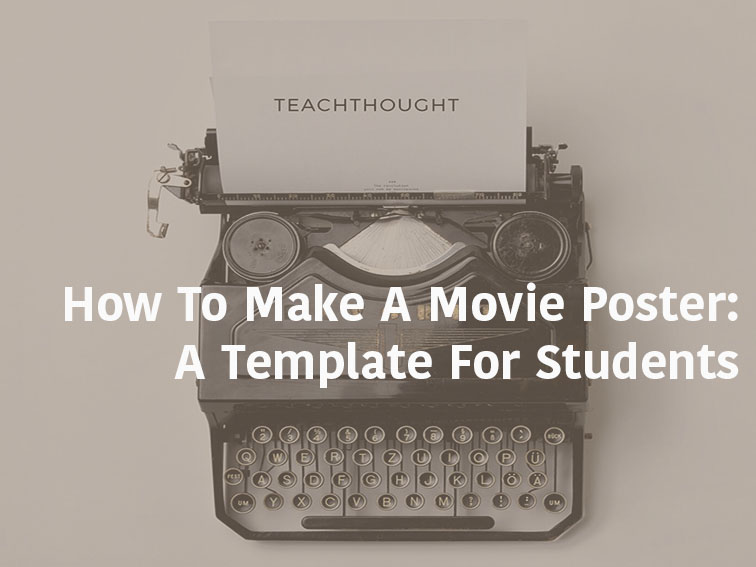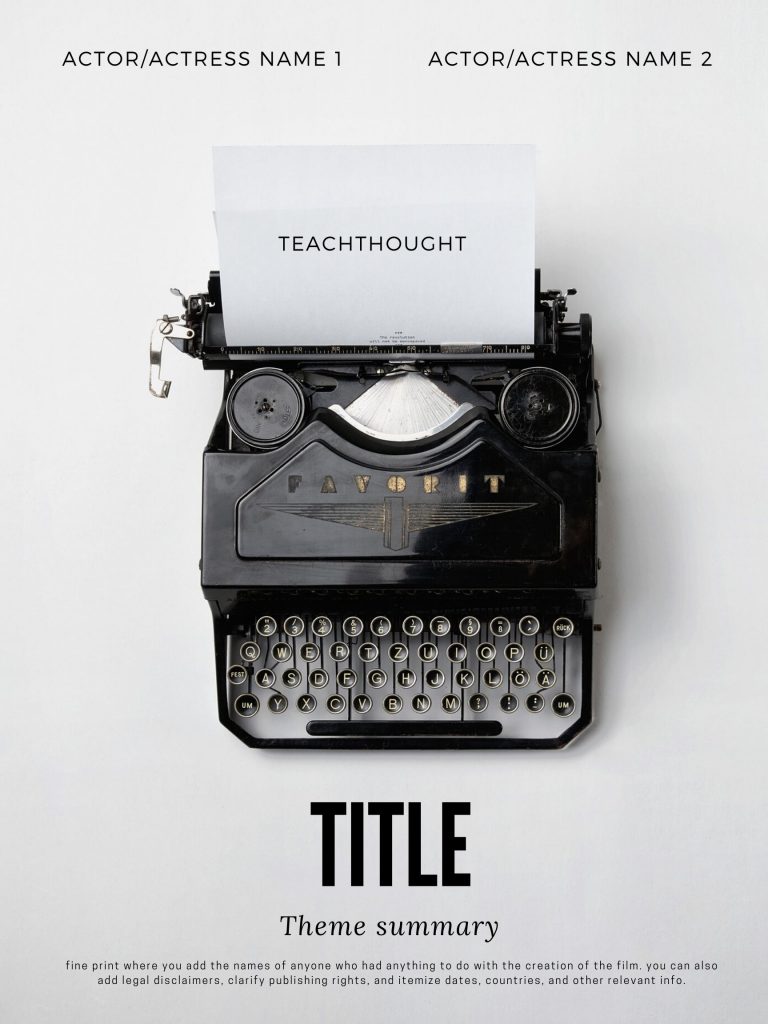
How To Make A Movie Poster (For Students)
by TeachThought Staff
Are you planning a book trailer for your students? Have them create and produce their own documentary or short film and share it on YouTube?
How about a kind of ‘writer’s antithesis’ assignment where students take an existing movie poster and create its tonal or thematic opposite?
However you plan on using it in the classroom, it doesn’t have to be complicated–and the simpler you make the logistics and design, the more students can focus on critical thinking about the movie or text.
What Is A Movie Poster?
A movie poster is a poster designed to attract potential moviegoers to see a movie.
Movieposters generally offer basic information like the title, the names of actors, actresses, directors, and producers while offering a visual of some kind that represents the movie and a ‘tagline’ or teaser used to further entice would-be movie patrons. That’s really it.
While there are different approaches and templates useful to advertise and market a particular movie, for teachers and students the primary draw for movie posters is that they require the movie poster creator to concisely ‘capture’ a film with the express purpose of convincing a certain audience to go see that film.
This isn’t unlike persuasive writing assignments or even a debate where students need to convince an audience to accept a premise or conclusion. In the case of the movie poster, the task is simple enough: Communicate key information about a movie in a way that persuades readers who otherwise may not be interested.
A second benefit of creating movie posters in the classroom is the ability to treat books as movies. Much like students creating ‘movie trailers’ for books, they can also create ‘movie posters’ for books as well. This not only demands the above elements of design and persuasion but it also can generate enthusiasm for reading by ‘framing’ a book as the seemingly-more-popular mediums of video and film.
In short, movie posters are useful ways to to generate thinking about and interest in books–or movies, for that matter. So how do you create one?

How To Create A Movie Poster In The Classroom
There are different approaches to creating a movie poster–especially in the classroom, where the focus is likely on the book and film and thinking about the book and film rather than increasing ticket sales and making a theater money.
Above, we’ve shown the most basic template/version used universally then added ‘how to’ steps below for actually ‘filling in’ that template. Obviously, you can create an infinite number of variations to this basic design. This template above is a good starting point for students to work from and see how easy creating a movie poster really is.
1. Watch the movie!
First things first: Watch the movie (or read the book)–and do so carefully and closely enough to know its ‘essence’ (see #3 below). This steps seems pretty obvious but–well, you just never know.
2. Identify key information.
At the most basic, this would be the movie title, the names of actors and actresses, the director’s name, and some kind of summarizing visual.
3. Decide (for yourself) what the ‘essence’ of the film is
This is the most important part of the movie poster: Capturing the film (or book) for what it ‘is’ and doing so in a way that doesn’t mislead viewers but makes it all look interesting enough to be worthy of their time.
Part of capturing the essence of the film is being able to identify the setting, context, theme, tone, and mood–and doing so in relation to potential moviegoers today. This would mean ‘capturing’ Shakespeare for a modern audience, for example–or at least distilling it for unfamilair viewers who don’t know what they’re missing.
For example, what is ‘Animal Farm” Is it a book about politics or a book about truth and propoganda? Is “The Hobbit” about good vs evil or the hidden potential in all of us? That good things come in small packages?
Being able to distill a story–to clarify what is really is at its core–requires close viewing or reading. It demands critical thinking about that story and all of its elements, and then the ability to succintly clarify them for a specific audience.
4. Decide on a size
Wikipedia has a list of various official movie posters sizes and also clarifies the differences between movie posters, lobby cards, teaser posters, and other kinds of movie posters typically used around the world. This may or may not be important, depending on how you’re using it with students.
5. Choose a movie poster template or design one from existing examples
You also need to decide if you’re going to draw one by hand or create it digitally.
6. Use the key information identified above to ‘fill in’ the template or create the poster from scratch
Top: The names of actors and actresses
Middle Top: Movie title
Middle Bottom: Teaser sentence or movie tagline (the aforementioned ‘essence’ can be useful here)
Very bottom: The fine print where you add the names of anyone who had anything to do with the creation of the film. You can also add legal disclaimers, clarify publishing rights, and itemize dates, countries, and other relevant info.
7. Publish the poster
Now it’s time to publish or share the movie poster–either for feedback to improve it, or to actually ‘market’ books to other readers. If no one ever sees the poster, what’s the point of making one?
Making a movie poster in the classroom; How To Make A Movie Poster: A Template For Students
